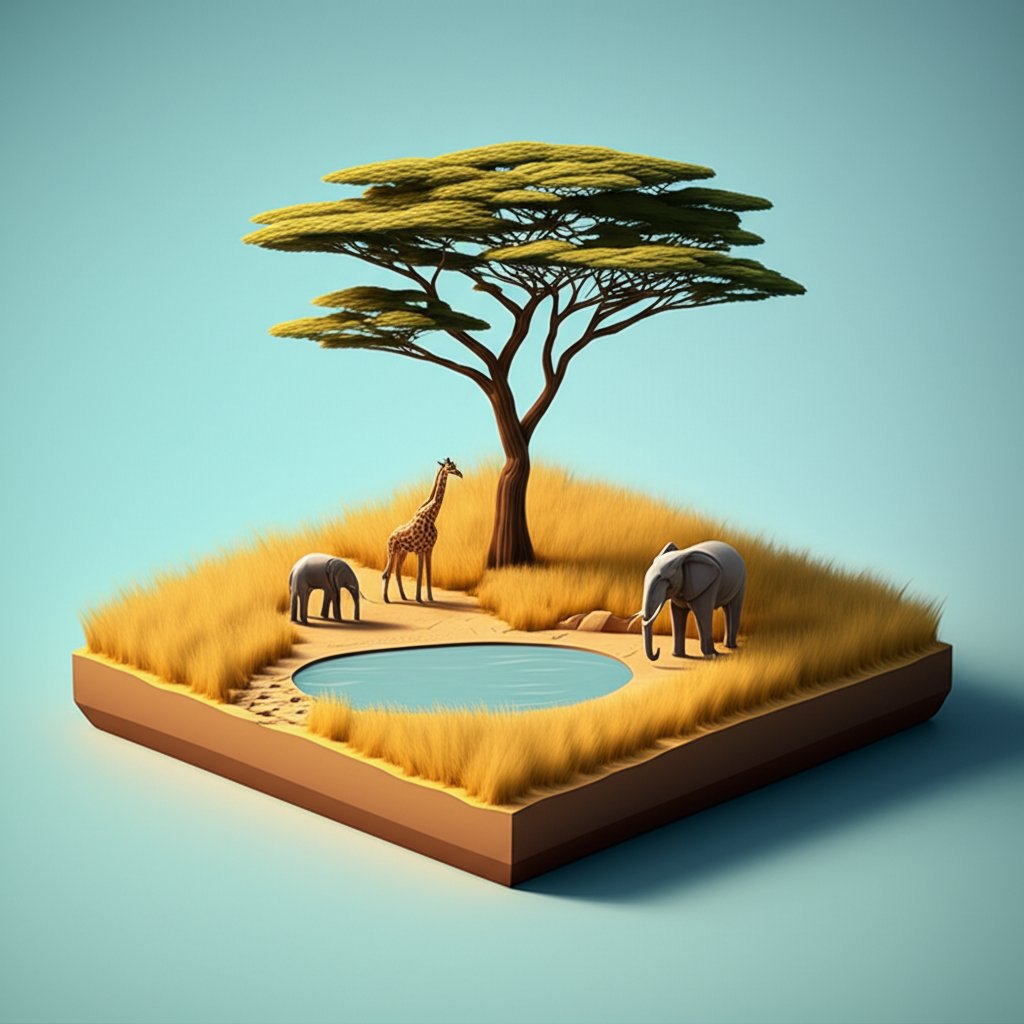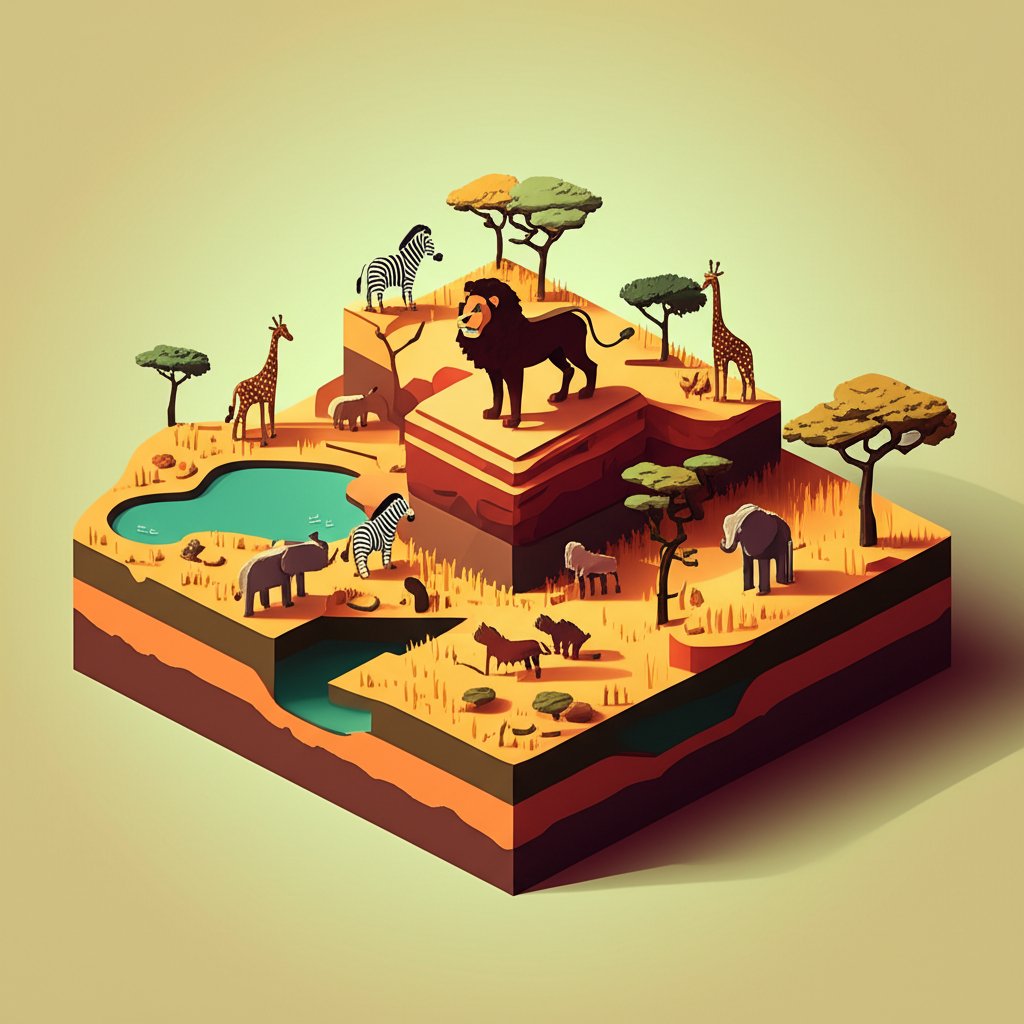Step into the heart of Africa, a landscape defined by boundless horizons, dramatic wildlife encounters, and an intricate dance of life and survival. The African Savanna is more than just a grassland; it’s a dynamic, breathtaking African Ecosystem that captivates with its raw beauty and profound ecological significance. From the thundering hooves of migrating herds to the silent wisdom of ancient baobabs, this iconic biome holds secrets that will leave you in awe.
Prepare to uncover 10 Jaw-Dropping African Savanna Facts that reveal the true majesty and complexity of this incredible place. We’re about to journey through the very fabric of the Savanna, exploring its unique inhabitants, extreme conditions, and pivotal role in our global environment. Get ready to have your understanding of African Wildlife and wild spaces completely transformed.
1. The Great Migration: Earth’s Most Epic Animal Journey
The African Savanna hosts the largest terrestrial mammal migration on Earth – an awe-inspiring spectacle involving millions of wildebeest, zebras, and gazelles. This isn’t just a casual stroll; it’s a relentless, year-long odyssey covering hundreds of miles across the Serengeti and Maasai Mara ecosystems.
Driven by Rain: The Quest for Green Pastures
The primary catalyst for this monumental movement is rain. As the dry season descends upon one region, herds are instinctually drawn towards areas where recent rains have stimulated fresh grass growth. They follow the promise of sustenance and water, essential for the survival of their young. This ceaseless search for vital resources perfectly illustrates the delicate balance within the African Ecosystem.
Predators and Prey: A Dance of Survival
For the predators of the Savanna, such as lions, hyenas, and cheetahs, the migration is a feast, albeit a challenging one. Weak or old animals often fall prey, an integral part of natural selection that strengthens the gene pool of the migratory species. Witnessing this primal struggle between life and death is one of the most profound Savanna Facts. It’s a testament to the raw, untamed essence of African Wildlife.
2. A Land of Two Faces: The Dominance of Wet and Dry Seasons
Unlike temperate zones with four distinct seasons, the African Savanna operates on a stark, binary rhythm of wet and dry seasons. These two periods dictate everything from animal behavior to plant growth, profoundly shaping the African Ecosystem.
The Wet Season’s Abundance
When the rains arrive, the parched plains erupt into a vibrant green wonderland. Waterholes overflow, rivers swell, and grasses shoot up, providing an abundance of food. This is a time of intense activity for African Wildlife: breeding cycles peak, young animals are born, and the entire landscape pulsates with life, showcasing the savanna’s incredible regenerative power.
The Dry Season’s Challenge
The dry season, by contrast, is a period of scarcity and hardship. Water sources shrink, grasses wither to golden husks, and temperatures soar. Animals must travel farther to find water and food, and many plant species enter a dormant state. This challenging period forces incredible adaptations, making survival a daily triumph and highlighting crucial Savanna Facts about resilience.
3. The Baobab: An Ancient Icon and Living Water Tower
While less dense than forests, the African Savanna is home to some of the most iconic and resilient trees on Earth, none more famous than the majestic Baobab. These giants are far from ordinary trees; they are living testaments to adaptation.
Water Storage Superstars
Known as the “Tree of Life” or “Upside-Down Tree,” the Baobab is nature’s ingenious solution to drought. Its massive, often hollow, trunk can store thousands of liters of water, earning it the nickname “water tower.” This astonishing ability allows it to thrive in the arid conditions of the Savanna, providing vital moisture for its own survival and sometimes even for thirsty animals.
Keystone Species and Ecosystem Support
Beyond water, the Baobab offers food (its fruit is packed with nutrients), shelter for countless creatures, and nesting sites for birds. Its presence is vital to the local African Ecosystem, acting as a keystone species that supports a wide array of African Wildlife. Other drought-resistant trees, like various species of Acacia, with their thorny defenses and deep root systems, also define the savanna’s unique arboreal landscape. These are just a few fascinating Savanna Facts about its flora.
4. Fire’s Dual Role: Destroyer and Creator
Many people see wildfires as purely destructive, but in the African Savanna, fire is an indispensable, natural process that plays a pivotal role in maintaining the health and balance of the African Ecosystem.
Shaping the Landscape for Millennia
Fires, often sparked by lightning or human activity, clear away old, tough vegetation, making way for new, nutritious grass shoots. This new growth is crucial for grazers like wildebeest and zebras. Without periodic fires, the savanna would eventually transform into dense bushland, altering the habitat for much of its characteristic African Wildlife. This makes fire an essential component of Savanna Facts.
Plant and Animal Adaptations to Fire
Many savanna plants have evolved to not just survive but thrive on fire. Grasses quickly regrow from their underground root systems, and some tree seeds require fire to germinate. Animals, too, have adapted. Larger animals flee, while smaller burrowing mammals dig deep for safety. This complex relationship with fire is a unique characteristic of the Savanna.
5. Global Reach with an African Heart: Savannas Worldwide
While the African Savanna is the most famous and extensive, similar grassland ecosystems exist on almost every continent. However, the sheer scale, biodiversity, and iconic African Wildlife of Africa’s savannas make them truly unparalleled.
Distributed Across Continents
From the Cerrado in South America to the sparse grasslands of northern Australia and the unique Rangelands of India, savannas share common characteristics: vast grasslands, scattered trees, and distinct wet and dry seasons. This global presence demonstrates the adaptability of this African Ecosystem model to various climatic zones.
Africa’s Unique Dominance
The savannas of Africa, particularly the well-known Serengeti-Maasai Mara and the Okavango Delta, stand out for their immense size and the spectacular concentrations of large animal species. This makes the African Savanna a global natural wonder, a primary focus for wildlife conservation, and a source of endless Savanna Facts.
6. A Hotbed of Biodiversity: Beyond the “Big Five”
When people think of African Wildlife, the “Big Five” (lion, leopard, elephant, rhino, buffalo) often come to mind. While these magnificent creatures are indeed central, the African Savanna is a mosaic of life, teeming with an astonishing array of species, large and small.
An Unseen World of Insects and Reptiles
Beyond the charismatic megafauna, the savanna is home to countless insects, birds, and reptiles that form the intricate web of this African Ecosystem. Termite mounds, for instance, are not just homes for insects; they are miniature ecosystems, providing shelter and hunting grounds for a diverse range of other animals. Learning about these smaller inhabitants reveals deeper Savanna Facts about the complexity of food chains.
Predator-Prey Masterclass
The open plains offer an unparalleled showcase of predator-prey dynamics. From cheetahs’ lightning-fast bursts to wild dogs’ synchronized hunts and lions’ powerful ambushes, every interaction is a lesson in adaptation and survival. This rich tapestry of life truly highlights the African Savanna’s status as a biodiversity hotspot.
7. Ingenious Plant Adaptations: The Unsung Heroes of Survival
The plants of the African Savanna are the unsung heroes of this harsh environment, evolving remarkable strategies to endure intense heat, limited water, and constant grazing pressure. Their clever adaptations are crucial Savanna Facts often overlooked.
Outsmarting Drought, Fire, and Hungry Herbivores
- Deep Taproots: Many trees and grasses develop incredibly long taproots, reaching deep into the soil to access underground water reserves during the dry season.
- Thorns and Toxins: To deter herbivores, many plants, especially acacia trees, are equipped with sharp thorns or produce chemical compounds that make their leaves unpalatable.
- Resilience to Fire: As mentioned, many grasses re-sprout quickly from protected underground bulbs or rhizomes after a fire, ensuring rapid recovery of the grazing grounds.
- Deciduous Nature: Many savanna trees are deciduous, shedding their leaves during the dry season to minimize water loss through transpiration, conserving precious moisture.
These adaptations allow the vegetation to thrive and support the abundant African Wildlife, underpinning the entire African Ecosystem.
8. The Savanna’s Critical Role in Global Climate Regulation
The African Savanna is not merely a regional phenomenon; it plays a significant, yet often underestimated, role in global climate regulation and carbon storage. This makes its preservation critical for the planet.
A Powerful Carbon Sink (and Source)
Through its vast grasslands and scattered trees, the Savanna takes in substantial amounts of carbon dioxide from the atmosphere. The extensive root systems of grasses and the biomass of trees act as natural carbon sinks. However, frequent fires can also release stored carbon, illustrating the complex dynamics of this African Ecosystem in the global carbon cycle. Understanding these nuanced Savanna Facts is vital for climate science.
Impact of Changing CO2 Levels
Rising atmospheric CO2 levels are having an interesting effect on parts of the African Savanna. Some studies suggest that increased CO2 can favor woody plant growth over grasses in certain areas, potentially leading to ‘bush encroachment’ or ‘woody encroachment’ which can alter the traditional grassland landscape. This dynamic shift highlights the savanna’s sensitivity to global climate change and its interconnectedness with broader environmental processes.
9. Humanity’s Ancient Cradle: Indigenous Cultures of the Savanna

For millennia, the African Savanna has not only been home to incredible African Wildlife but also to diverse indigenous cultures whose lives are deeply intertwined with the land. Their presence adds a profound layer to the African Ecosystem’s story.
Living in Harmony with Nature
Communities like the Maasai, Samburu, and Datoga have developed intricate knowledge systems and sustainable practices for coexisting with the savanna’s resources and its wild inhabitants. Their traditional pastoral lifestyles rely on the health of the grasslands and the availability of water, fostering a deep respect for natural cycles. Their traditional knowledge offers invaluable Savanna Facts about sustainable living.
Guardians of Biocultural Heritage
These cultures are not just residents; they are guardians of a rich biocultural heritage, where human traditions, folklore, and survival strategies are inseparable from the savanna’s ecology. Their way of life, often under threat from modern development and climate change, underscores the importance of a holistic approach to conservation that includes both nature and culture within the African Savanna.
10. The Battle for Survival: Conservation in a Changing World
Despite its resilience and vital global role, the African Savanna faces unprecedented threats, making conservation efforts more critical than ever to protect its unique African Wildlife and African Ecosystem.
Major Threats: Habitat Loss, Poaching, and Climate Change
Habitat loss due to agricultural expansion, human settlements, and infrastructure development is rapidly fragmenting savanna landscapes. Poaching continues to decimate populations of iconic species like elephants and rhinos. Furthermore, the impacts of climate change – altered rainfall patterns, increased droughts, and more intense fires – directly threaten the delicate balance of the Savanna.
The Urgency of Conservation
Dedicated individuals, organizations, and governments are working tirelessly to protect the African Savanna. This includes establishing national parks and wildlife reserves, implementing anti-poaching initiatives, promoting eco-tourism, and fostering community-based conservation programs. Understanding these pressing Savanna Facts motivates global action. The future of this magnificent African Ecosystem and its incredible African Wildlife depends on sustained, collaborative efforts to ensure its survival for generations to come.
Conclusion: The Enduring Majesty of the African Savanna
From the epic migrations that define its seasons to the ancient baobabs that stand as silent sentinels, the African Savanna is a place of unparalleled wonder and vital ecological importance. We’ve explored just 10 Jaw-Dropping African Savanna Facts, but each one unveils a deeper layer of the incredible resilience, intricate interconnections, and profound beauty that characterize this magnificent African Ecosystem.
The Savanna is a living testament to nature’s power, a crucible where African Wildlife thrives against immense odds, and a landscape that continues to shape human history. Its health is intrinsically linked to our planet’s well-being, demanding our respect, understanding, and unwavering commitment to conservation. So, next time you think of the wild, remember the golden plains of the African Savanna – a truly extraordinary place.
FAQ: Your Questions About the African Savanna Answered

Q1: Where exactly is the African Savanna located?
A1: The African Savanna stretches across vast areas of sub-Saharan Africa, covering roughly half of the continent. Key regions include East Africa (like the Serengeti and Maasai Mara in Tanzania and Kenya), Southern Africa (parts of Botswana, Zambia, and Zimbabwe), and parts of West and Central Africa.
Q2: What are the main characteristics of the Savanna biome?
A2: The Savanna biome is primarily characterized by vast grasslands with scattered trees (like acacia and baobab), a warm climate year-round, and distinct wet and dry seasons. It supports a high diversity of large grazing mammals and their predators, making it a unique and dynamic African Ecosystem.
Q3: How do animals in the African Savanna find water during the dry season?
A3: African Wildlife employs various strategies to find water during the dry season. Many species, such as wildebeest and zebras, undertake long migrations to areas with permanent rivers or waterholes. Others, like elephants, use their tusks to dig for underground water. Some animals, like the oryx, can extract moisture from the plants they eat, showing incredible adaptation to the Savanna’s challenges.
Q4: Are all savannas the same as the African Savanna?
A4: While all savannas share general characteristics (grasslands with scattered trees, distinct wet/dry seasons), the African Savanna is unique due to its immense scale and the unparalleled diversity and concentration of large mammal species (e.g., elephants, lions, giraffes, zebras). Other savannas exist in South America (Cerrado), Australia, and India, each with its own specific flora and fauna.
Q5: What is the biggest threat to the African Savanna today?
A5: The African Savanna faces multiple significant threats. Habitat loss and fragmentation due to human population growth, agriculture, and infrastructure development are major concerns. Poaching of iconic African Wildlife for illicit trade, and the increasing impacts of climate change (e.g., more frequent droughts, altered rainfall patterns, bush encroachment), also pose severe risks to this vital African Ecosystem.
Q6: Can tourists visit the African Savanna, and what’s the best time?
A6: Yes, the African Savanna is a major destination for wildlife tourism, with numerous national parks and reserves offering safaris. The best time to visit often depends on what you want to see. The dry season (roughly June to October in East Africa) is excellent for wildlife viewing as animals congregate around water sources, making them easier to spot. However, the wet season offers lush landscapes and newborn animals.
Q7: What role do termites play in the African Savanna?
A7: Termites are surprisingly crucial to the African Ecosystem. Their mounds not only provide homes for the termites themselves but also serve as shelter and food sources for a variety of other African Wildlife, including mongoose, aardvarks, and birds. Termites also play a vital role in nutrient cycling, breaking down dead plant material and enriching the soil. These fascinating Savanna Facts reveal the importance of even the smallest creatures.










